Assessment of the Impact of COVID-19 on Operations of Local Businesses and Level of Enforcement of Public Health Safety Measure within Business Premises: A Quantitative Study of Businesses in Huye-Rwanda
Abstract
:1. Introduction
2. Literature Review
2.1. Theories
2.2. Known Studies
3. Materials and Methodology
3.1. The Questionnaire
- Specific impacts of COVID-19 on business operations
- Enforcement of the public health safety measures
- Perception towards automated public health safety measure enforcement systems
3.2. Survey Sample
3.3. Data Analysis
4. Results and Discussion
4.1. The COVID-19 Pandemic Has Impacted the Turnover of Businesses
4.2. There Is a Need for Temporary Measures by the Government to Help Businesses Cope
4.3. Businesses Are Experiencing Challenges to Accessing Inputs and Selling Outputs
4.4. Businesses Have Adopted Some Strategies to Cope with the Effects of the Pandemic
4.5. Most Businesses Have Put in Place Interventions to Enforce Public Health Safety and Meaasures to Safeguard Employees and Clients/Customers
4.6. Many Businesses Have Put in Place Measures to Enforce Social Distance Requirement within the Business Premises
5. Comparison Discussion and Study Limitations
6. Conclusions and Future Work
Author Contributions
Funding
Data Availability Statement
Conflicts of Interest
References
- Swelum, A.A.; Shafi, M.E.; Albaqami, N.M.; El-Saadony, M.T.; Elsify, A.; Abdo, M.; Mohamed, E. COVID-19 in Human, Animal, and Environment: A Review. Front. Vet. Sci. 2020, 7, 578. [Google Scholar] [CrossRef] [PubMed]
- Kiros, M.; Andualem, H.; Kiros, T.; Hailemichael, W.; Getu, S.; Geteneh, A.; Abegaz, W.E. COVID-19 Pandemic: Current Knowledge about the Role of Pets and other Animals in Disease Transmission. Virol. J. 2020, 17, 1–8. [Google Scholar] [CrossRef] [PubMed]
- Semakula, M.; Niragire, F.; Umutoni, A.; Nsanzimana, S.; Ndahindwa, V.; Rwagasore, E.; Nyatanyi, T.; Remera, E.; Faes, C. The secondary transmission pattern of COVID-19 based on contact tracing in Rwanda. BMJ Glob. Health 2021, 6, e004885. [Google Scholar] [CrossRef] [PubMed]
- Modes of Transmission of Virus Causing COVID-19: Implications for IPC Precaution Recommendations. Available online: https://www.who.int/news-room/commentaries/detail/modes-of-transmission-of-virus-causing-COVID-19-implications-for-ipc-precautiion-recommendation (accessed on 20 June 2021).
- Cascella, M.; Rajnik, M.; Aleem, A.; Dulebohn, S.C.; Napoli, R.D. Features, Evaluation, and Treatment of Coronavirus (COVID-19). 2021. Available online: https://www.statpearls.com/ArticleLibrary/viewarticle/52171 (accessed on 20 June 2021).
- Wang, X.; Pan, Z.; Cheng, Z. Association between 2019-nCOV transmission and N95 respiratory use. J. Hosp. Infect. 2020, 105, P104-105. [Google Scholar] [CrossRef] [Green Version]
- Pak, A.; Adegboye, O.A.; Adekunle, A.I.; Rahman, K.M.; McBryde, E.S.; Eisen, D.P. Economic Consequences of the COVID-19 Outbreak: The Need for Epidemic Preparedness. Front. Public Health 2020, 8, 241. [Google Scholar] [CrossRef] [PubMed]
- Morsy, H.; Balma, L.; Mukasa, A.N. ‘Not a Good Time’: Economic Impact of COVID-19 in Africa. Working Paper Series N0 338. Africa Development Bank, Abidjan. Ivory Coast. Available online: https://www.afdb.org/sites/default/files/documents/publications/wps_no_338_not_a_good_time_economic_impact_of_COVID-19_in_africa_.pdf (accessed on 20 June 2021).
- Micro Small Medium Enterprises in Rwanda. Available online: https://fortuneofafrica.com/rwanda/micro-small-medium-enterprises-in-rwanda/ (accessed on 1 July 2021).
- Padidar, S.; Liao, S.-M.; Magagula, S.; Mahlaba, T.A.M.; Nhlabatsi, N.M.; Lukas, S. Assessment of early COVID-19 compliance to and challenges with public health and social prevention measures in the Kingdom of Eswatini, using an online survey. PLoS ONE 2021, 16, e0253954. [Google Scholar] [CrossRef] [PubMed]
- Kumar, A.; Luthra, S.; Mangla, S.K.; Kazançoğlu, Y. COVID-19 impact on sustainable production and operations management. Sustain. Oper. Comput. 2020, 1, 1–7. [Google Scholar] [CrossRef]
- Harapan, H.; Itoh, N.; Yufika, A.; Winardi, W.; Keam, S.; Te, H.; Megawati, D.; Hayati, Z.; Wagner, A.L.; Mudatsir, M. Coronavirus disease 2019 (COVID-19): A literature review. J. Inf. Public Health 2020, 13, 667–673. [Google Scholar] [CrossRef]
- Fairlie, R. The impact of COVID-19 on small business owners: Evidence from the first three months after widespread social-distancing restrictions. J. Econ. Manag. Strategy 2020, 29, 727–740. [Google Scholar] [CrossRef] [PubMed]
- Haleem, A.; Javaid, M.; Vaishya, R. Effects of COVID-19 pandemic in daily life. Curr. Med. Res. Pract. 2020, 10, 78–79. [Google Scholar] [CrossRef] [PubMed]
- Uzair Younus, The Impact of COVID-19 on South Asian Economies, No. 500, Aug. 2021, United States Institute of Peace. Available online: https://www.usip.org/publications/2021/08/impact-COVID-19-south-asian-economies (accessed on 1 July 2021).
- Available online: https://eprcug.org/publication/652-how-has-the-COVID-19-pandemic-impacted-ugandan-businesses-results-from-a-business-climate-survey/ (accessed on 1 July 2021).
- Available online: https://www.mainstreet.org/blogs/national-main-street-center/2020/04/09/new-report-the-impact-of-COVID-19-on-small-busines (accessed on 1 October 2021).
- COVID-19 and Women-led MSMEs in Sub-Saharab Africa: Examining the Impacts, Responses and Solutions, Report by International Finance Corporation, Release March 2021. Available online: https://www.ifc.org/wps/wcm/connect/industry_ext_content/ifc_external_corporate_site/financial+institutions/resources/covid19-and-women-led-firms-in-africa (accessed on 1 October 2021).
- Available online: https://www.osha.gov/sites/default/files/publications/OSHA3990.pdf (accessed on 1 October 2021).
- A Safe and Healthy Return to Work during the COVID-19 Pandemic, Labour Administration, Labour Inspection and Occupa-tional Safety and Health Branch (LABADMIN/OSH) Governance and Tripartism Department, International Labor Organiza-tion. Available online: https://www.ilo.org/wcmsp5/groups/public/---ed_protect/---protrav/---safework/documents/briefingnote/wcms_745549.pdf (accessed on 1 October 2021).
- Sharifi, A.; Khavarian-Garmsir, A.R. The COVID-19 pandemic: Impacts on cities and major lessons for urban planning, design, and management. Sci. Total. Environ. 2020, 749, 142391. [Google Scholar] [CrossRef]
- The Territorial Impact of COVID-19: Managing the Crisis Across Levels of Government. Available online: https://www.oecd.org/coronavirus/policy-responses/the-territorial-impact-of-COVID-19-managing-the-crisis-across-levels-of-government-d3e314e1/ (accessed on 1 October 2021).
- Acuto, M. Engaging with global urban governance in the midst of a crisis. Dialogues- Hum. Geogr. 2020, 10, 221–224. [Google Scholar] [CrossRef]
- Aguliera, E.; Nightengale-Lee, B. Emergency remote teaching across urban and rural contexts: Perspec-tives on educational equity. Inf. Learn. Sci. 2020, 121, 471–478. [Google Scholar] [CrossRef]
- Aloi, A.; Alonso, B.; Benavente, J.; Cordera, R.; Echániz, E.; González, F.; Ladisa, C.; Lezama-Romanelli, R.; López-Parra, A.; Mazzei, V.; et al. Effects of the COVID-19 lockdown on urban mobility: Empirical evidence from the city of Santander (Spain). Sustainability 2020, 12, 3870. [Google Scholar] [CrossRef]
- Batty, M. The coronavirus crisis: What will the post-pandemic city look like? Environ. Plan. B Urban Anal. City Sci. 2020, 47, 547–552. [Google Scholar] [CrossRef]
- Bherwani, H.; Nair, M.; Musugu, K.; Gautam, S.; Gupta, A.; Kapley, A.; Kumar, R. Valuation of air pollution externalities: Com-parative assessment of economic damage and emission reduction under COVID-19 lockdown. Air Qual. Atmos. Health 2020, 13, 683–694. [Google Scholar] [CrossRef]
- Bhowmick, G.D.; Dhar, D.; Nath, D.; Ghangrekar, M.M.; Banerjee, R.; Das, S.; Chatterjee, J. Coronavirus disease 2019 (COVID-19) outbreak: Some serious consequences with urban and rural water cycle. NPJ Clean Water 2020, 3, 1–8. [Google Scholar] [CrossRef]
- Horn, S.; Vogt, B.; Pieters, R.; Bouwman, H.; Bezuidenhout, C. Impact of potential COVID-19 treatment on south African water sources already threatened by pharmaceutical pollution. Environ. Toxicol. Chem. 2020, 39, 1305–1306. [Google Scholar] [CrossRef] [Green Version]
- Castillo, R.; Amoah, P.A. Africans in post-COVID-19 pandemic China: Is there a future for China’s ‘new minority’? Asian Ethn. 2020, 21, 560–565. [Google Scholar] [CrossRef]
- Honey-Rosés, J.; Anguelovski, I.; Chireh, V.K.; Daher, C.; Konijnendijk van den Bosch, C.; Litt, J.S.; Mawani, V.; McCall, M.K.; Orellana, A.; Oscilowicz, E.; et al. The impact of COVID-19 on public space: An early review of the emerging questions—Design, perceptions and inequities. Cities Health 2020, 1–17. [Google Scholar] [CrossRef]
- Kummitha, R.K.R. Smart technologies for fighting pandemics: The techno- and human- driven approaches in controlling the virus transmission. Gov. Inf. Q. 2020, 37, 101481. [Google Scholar] [CrossRef] [PubMed]
- Hoorens, S.; Hocking, L.; Fays, C. How Small Businesses Are Coping with the Impact of COVID-19: Results from a Survey in Turkey and the Middle East, 2020. Available online: https://web.archive.org/web/20200905231959id_/https://www.rand.org/content/dam/rand/pubs/research_reports/RRA600/RRA607-1/RAND_RRA607-1.pdf (accessed on 1 October 2021).
- The Impact of COVID-19 on African SMMEs Operations: Insights from Entrepreneurs and Business Development Services (BDS) Providers. Available online: https://www.google.com/url?client=internal-element-cse&cx=0903a1a109a46b6e5&q=https://www.goethe.de/resources/files/pdf208/c4g-the-impact-of-COVID-19-on-african-smmes-operations-online.pdf&sa=U&ved=2ahUKEwjKwa294dHzAhXaAGMBHRbSBjIQFnoECAkQAQ&usg=AOvVaw0Rr6v--qPWYhGwZZpb0PSR (accessed on 1 October 2021).
- Lakuma, C.P.; Sunday, N. Impact of COVID-19 on Micro, Small, and Medium Businesses in Uganda, 2021. Available online: https://www.brookings.edu/blog/africa-in-focus/2020/05/19/impact-of-COVID-19-on-micro-small-and-medium-businesses-in-uganda/ (accessed on 1 October 2021).
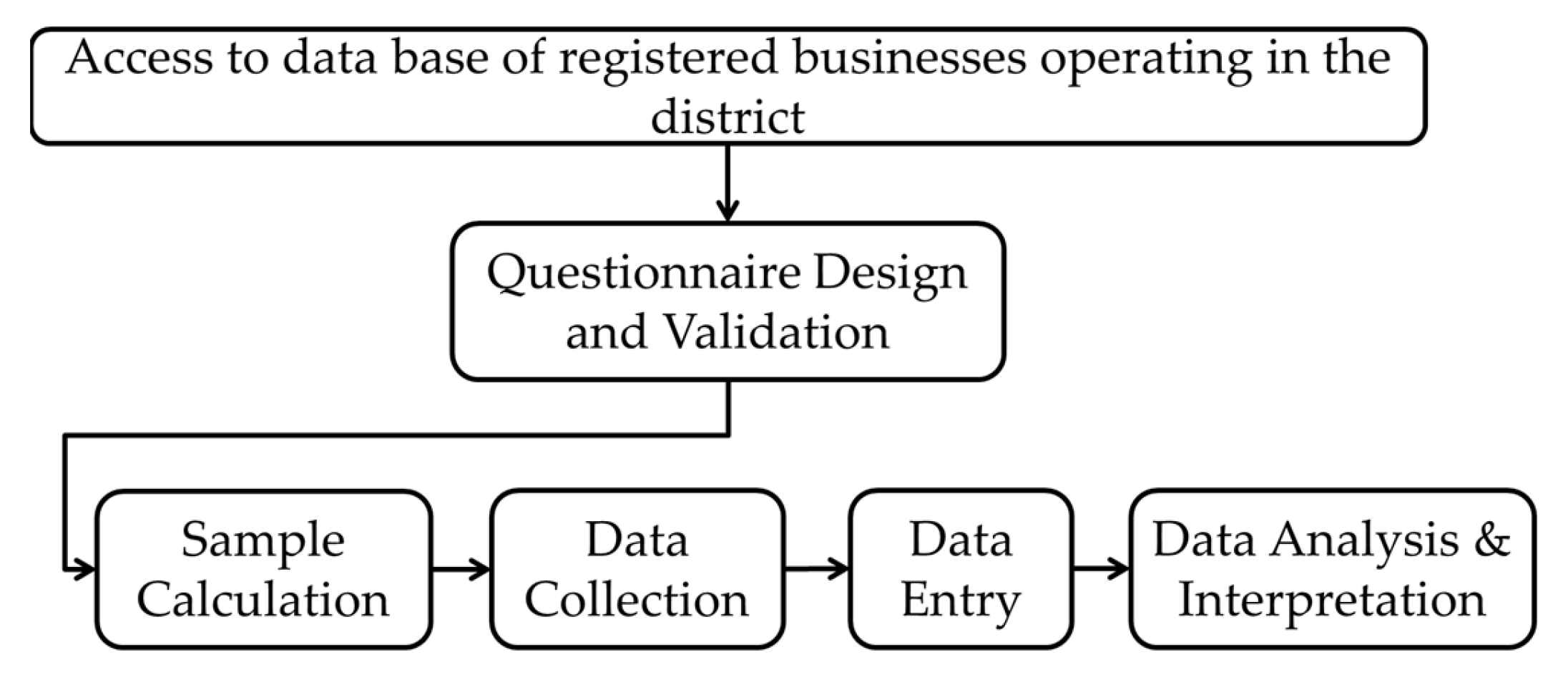
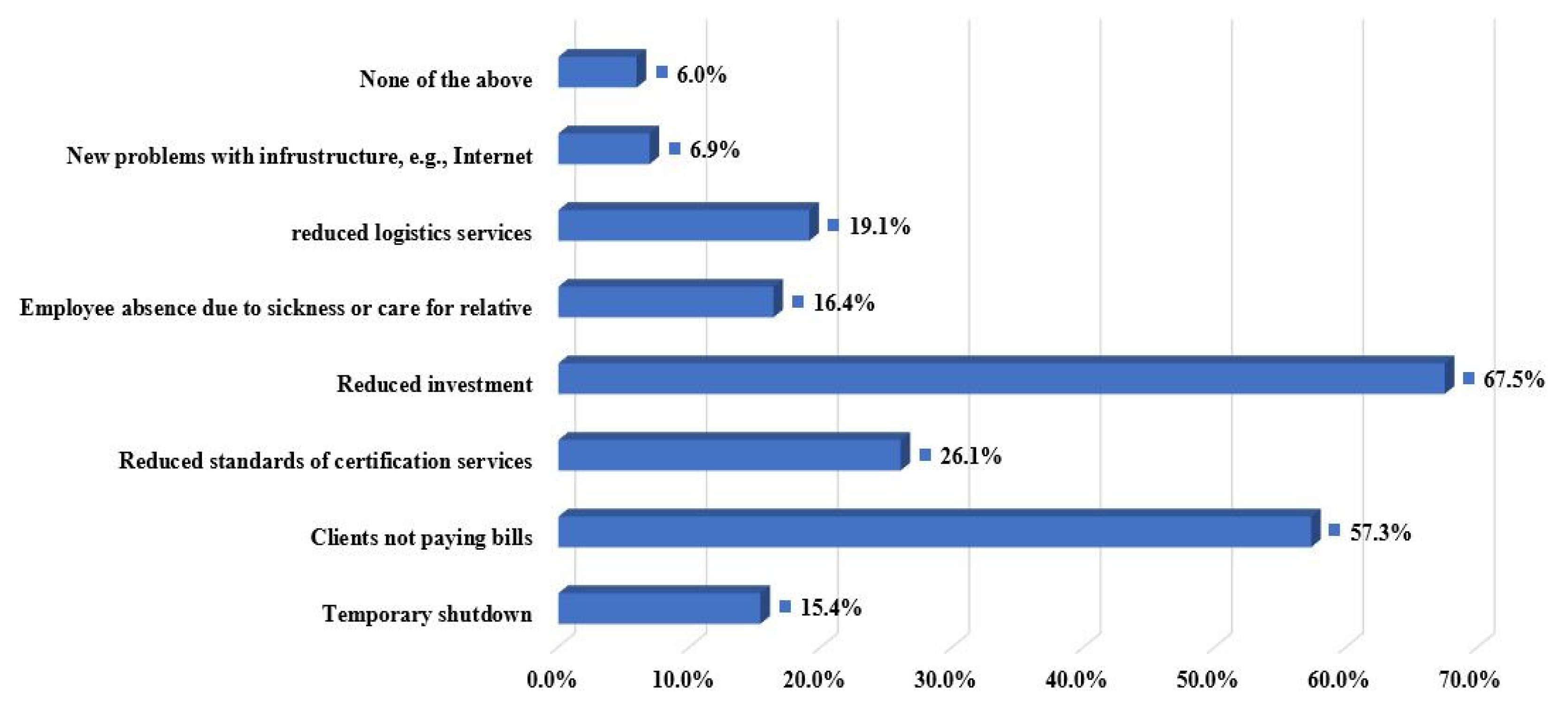
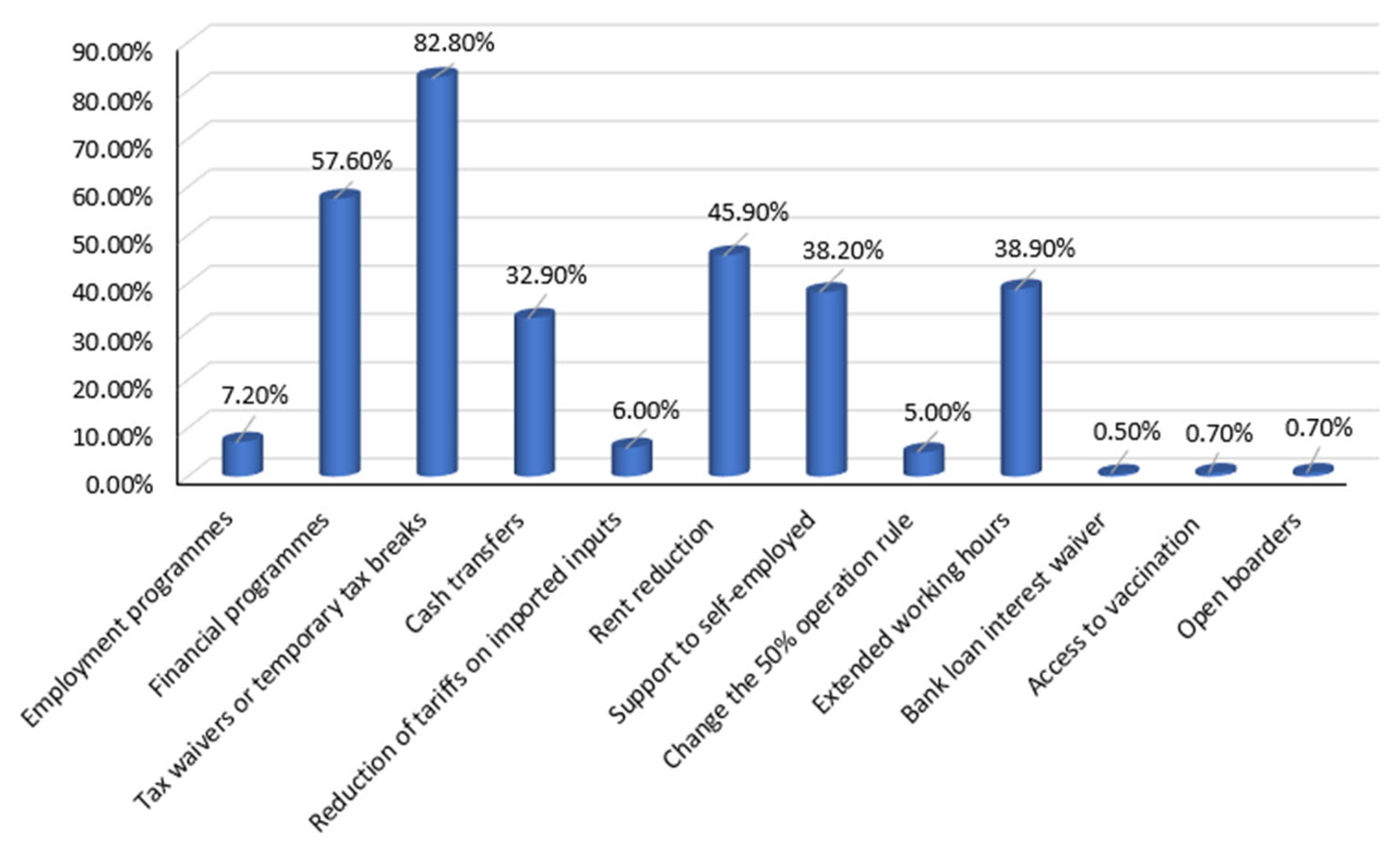
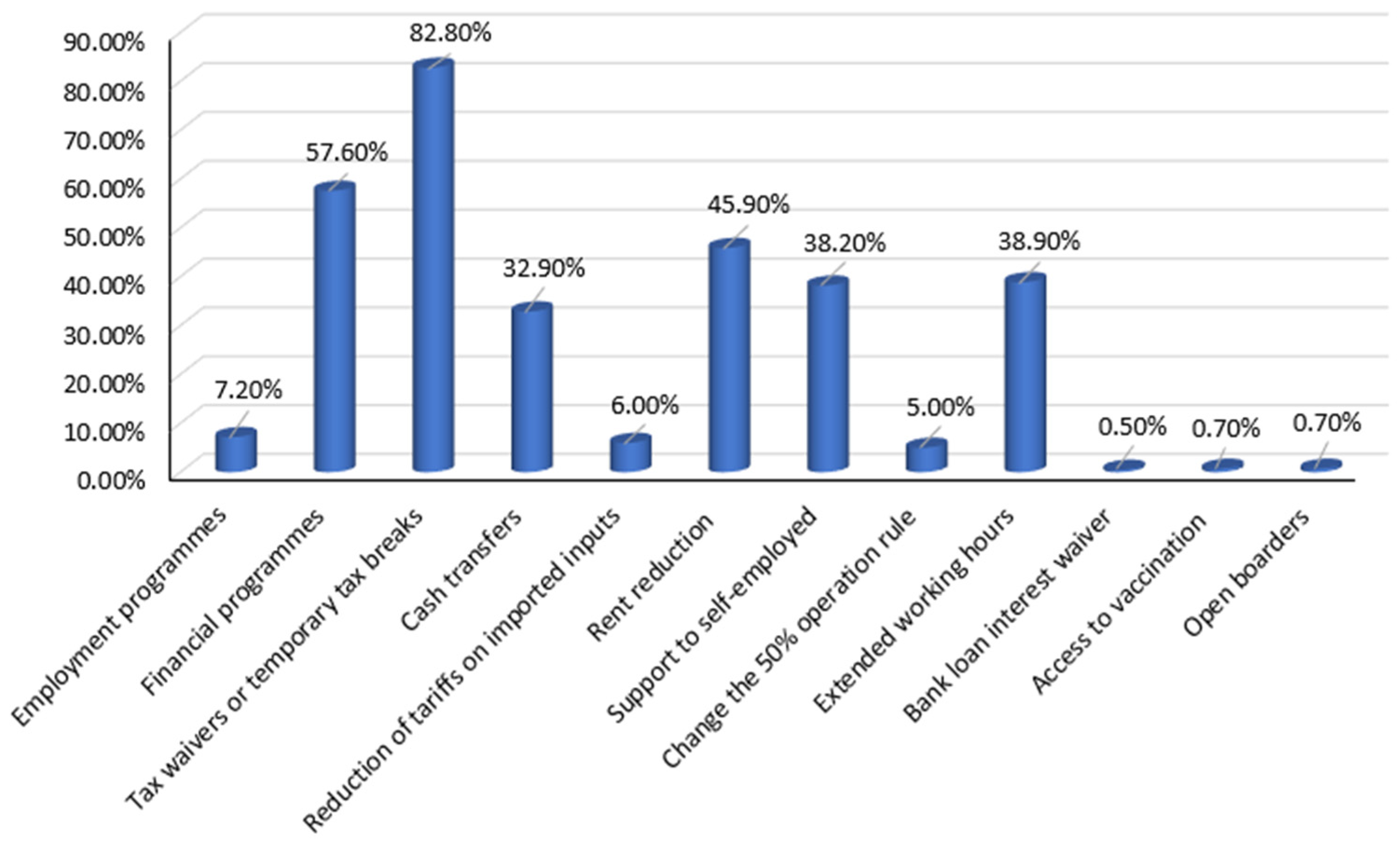
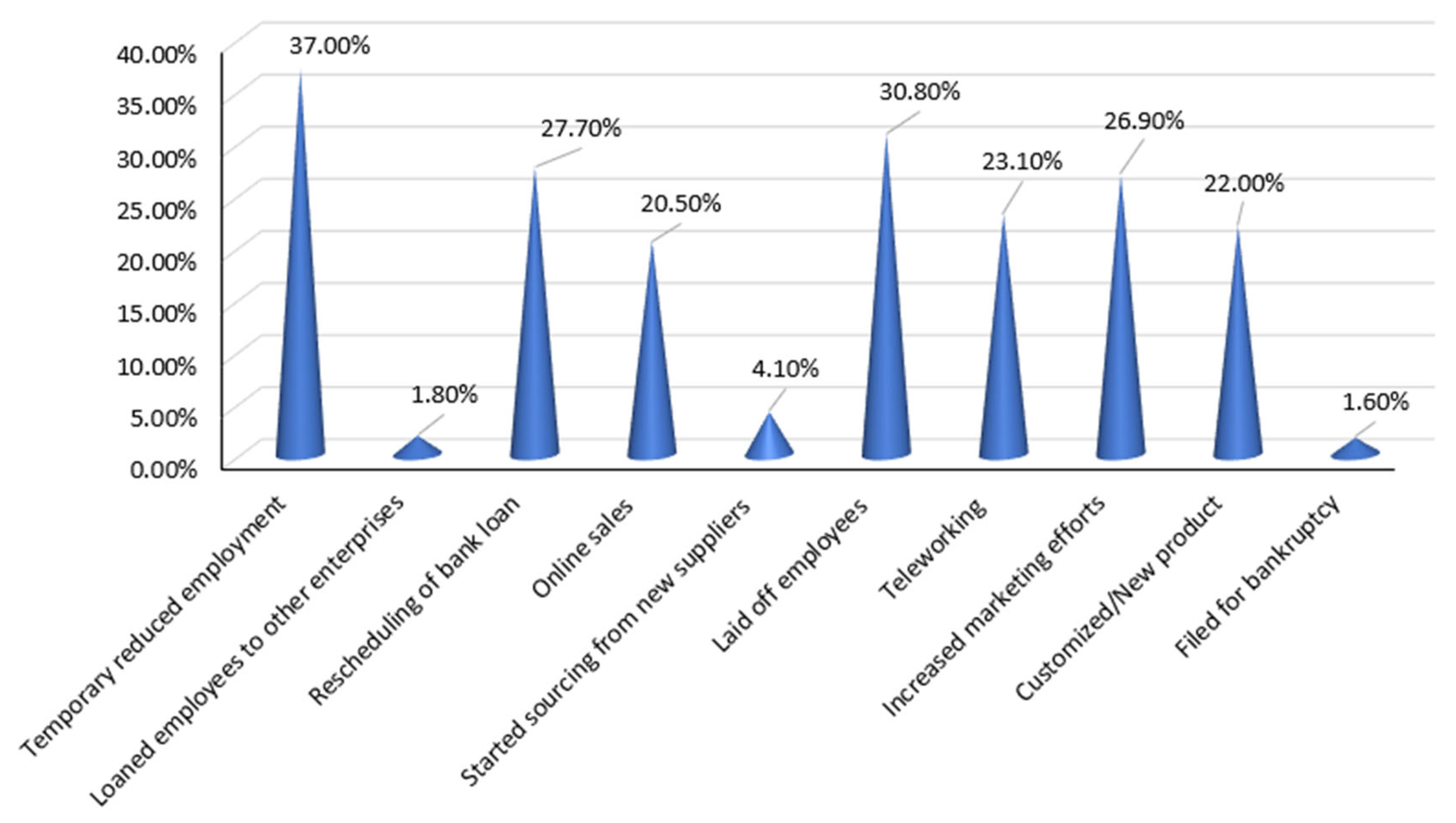
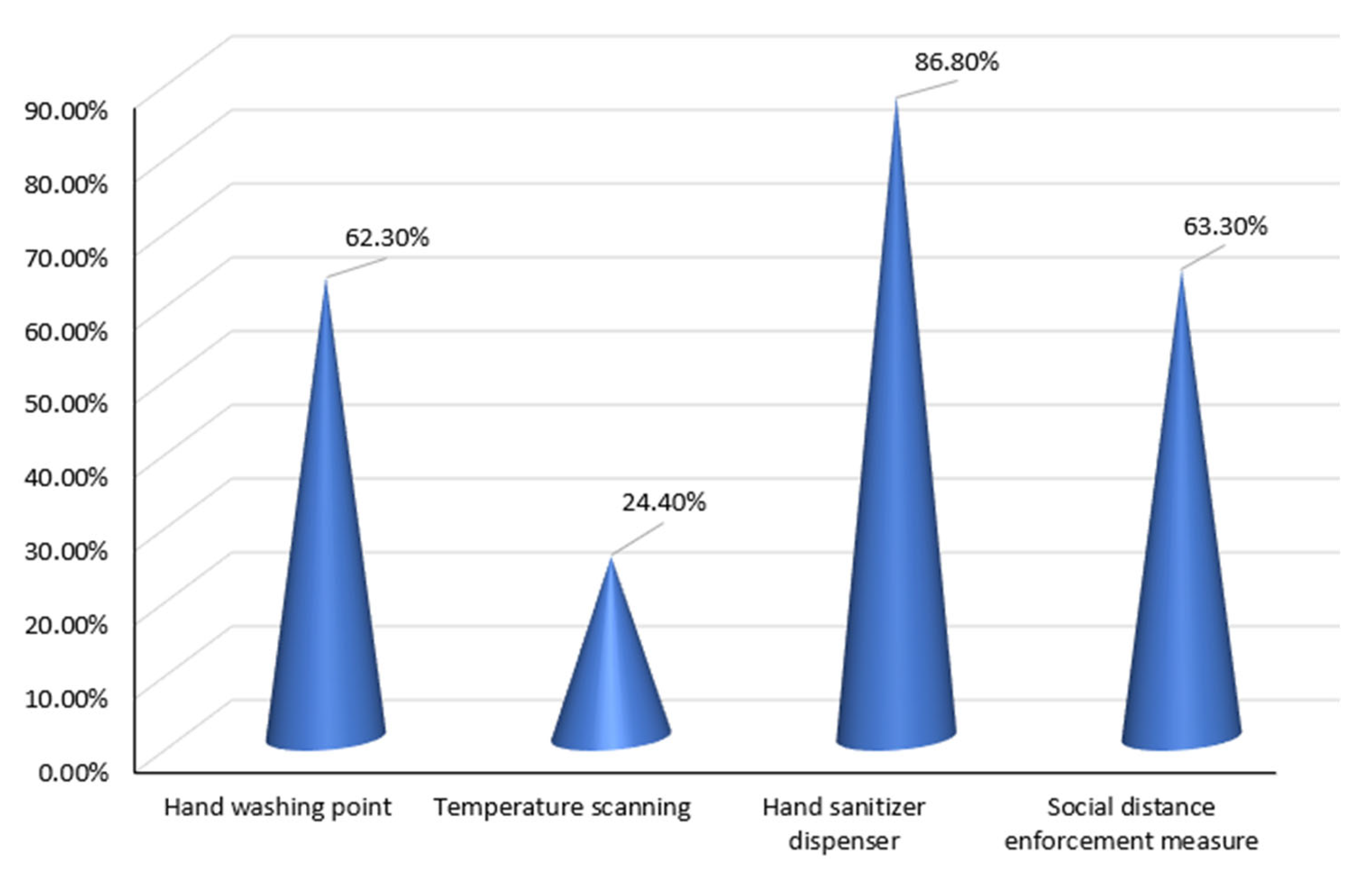
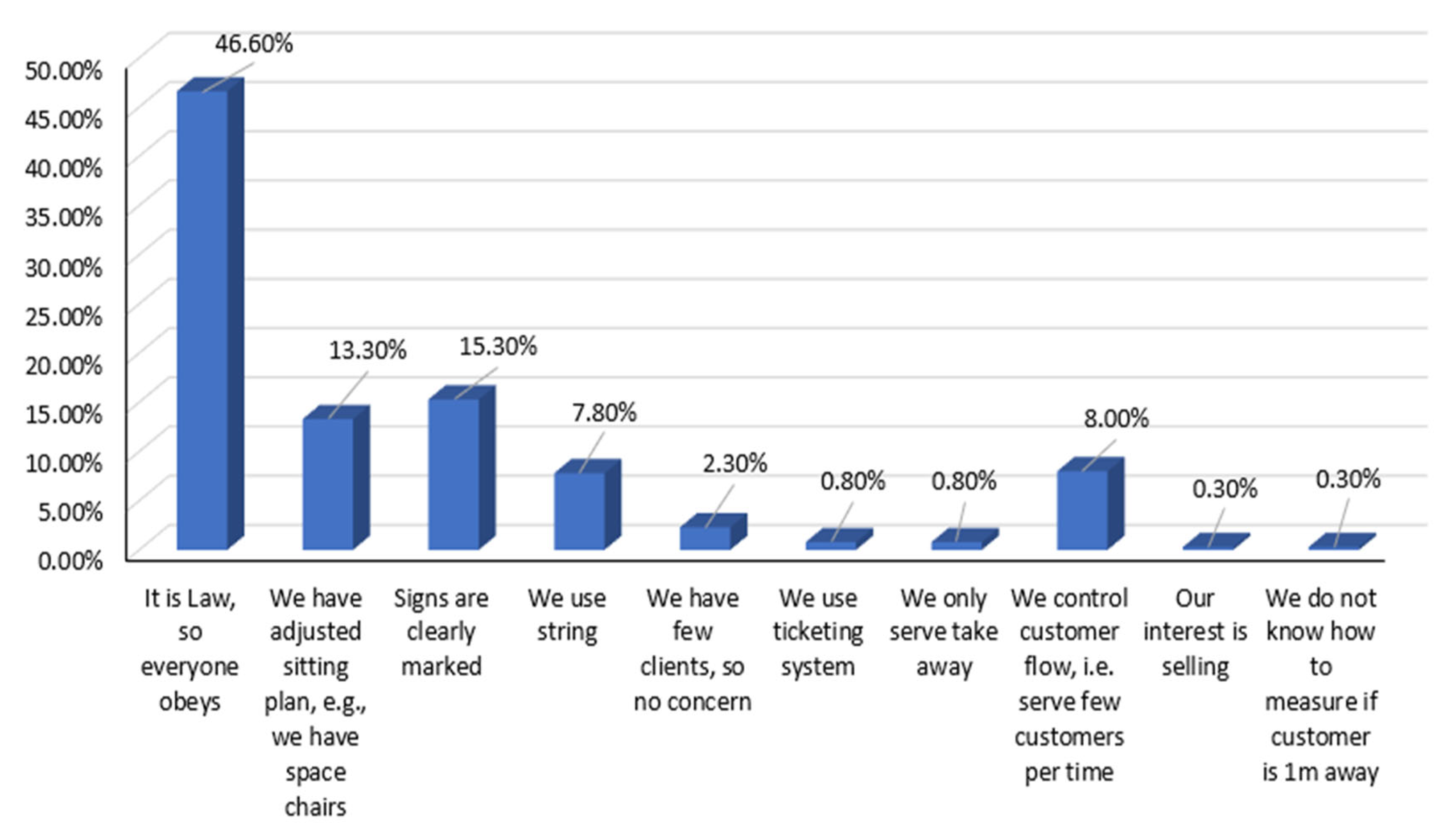
Publisher’s Note: MDPI stays neutral with regard to jurisdictional claims in published maps and institutional affiliations. |
© 2021 by the authors. Licensee MDPI, Basel, Switzerland. This article is an open access article distributed under the terms and conditions of the Creative Commons Attribution (CC BY) license (https://creativecommons.org/licenses/by/4.0/).
Share and Cite
Twahirwa, E.; Mtonga, K.; Jayavel, K.; Kasakula, W.; Bamurigire, P. Assessment of the Impact of COVID-19 on Operations of Local Businesses and Level of Enforcement of Public Health Safety Measure within Business Premises: A Quantitative Study of Businesses in Huye-Rwanda. Sustainability 2021, 13, 13013. https://doi.org/10.3390/su132313013
Twahirwa E, Mtonga K, Jayavel K, Kasakula W, Bamurigire P. Assessment of the Impact of COVID-19 on Operations of Local Businesses and Level of Enforcement of Public Health Safety Measure within Business Premises: A Quantitative Study of Businesses in Huye-Rwanda. Sustainability. 2021; 13(23):13013. https://doi.org/10.3390/su132313013
Chicago/Turabian StyleTwahirwa, Evariste, Kambombo Mtonga, Kayalvizhi Jayavel, Willie Kasakula, and Peace Bamurigire. 2021. "Assessment of the Impact of COVID-19 on Operations of Local Businesses and Level of Enforcement of Public Health Safety Measure within Business Premises: A Quantitative Study of Businesses in Huye-Rwanda" Sustainability 13, no. 23: 13013. https://doi.org/10.3390/su132313013
APA StyleTwahirwa, E., Mtonga, K., Jayavel, K., Kasakula, W., & Bamurigire, P. (2021). Assessment of the Impact of COVID-19 on Operations of Local Businesses and Level of Enforcement of Public Health Safety Measure within Business Premises: A Quantitative Study of Businesses in Huye-Rwanda. Sustainability, 13(23), 13013. https://doi.org/10.3390/su132313013






